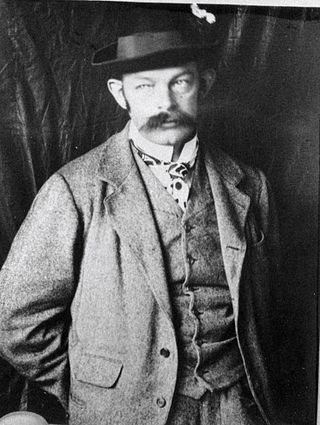Ludwig Hans Fischer (2 March 1848 - 24 April 1915) was an Austrian landscape painter, copper engraver, etcher and ethnologist. He was noted for his paintings of Oriental subjects, especially African and Indian women wearing traditional costume.
Ludwig Hans Fischer (2 March 1848 - 24 April 1915) was an Austrian landscape painter, copper engraver, etcher and ethnologist. He was noted for his paintings of Oriental subjects, especially African and Indian women wearing traditional costume.
A pupil, at the Vienna Academy of Fine Arts, of Eduard von Lichtenfels in painting, of Louis Jacoby in engraving, and of William Unger in etching. [1] After completing his studies, in around 1875, he travelled to Italy, Spain, Egypt, Tunisia, Libya, Egypt, Palestine and India before settling in Vienna. In 1879 he exhibited in Vienna and in the same year, he returned to the Orient. During these travels, he prepared many watercolours and sketches in situ. [2]
In 1875, he received a grant to travel to the Middle East and Palestine; a journey that resulted in the publication of a sketchbook. In 1879, he published another sketchbook following his travels to Turkey, Jerusalem and the Dead Sea. [3]
In addition to a number of oil paintings, he prepared nine large landscapes for the Vienna Museum of Natural History in 1889. Among his series of etchings and engravings, the set published as Historical Landscapes from Austria-Hungary is his most remarkable production. He also painted many water-colors, produced illustrations for a number of books. [1] and designed a number of coins for the Numismatic Society of Vienna. [4]
He was an active member of Vienna's arts culture, through his membership of art groups. He founded the Watercolourists Club in his home city. [4]
Fischer was also writer. [5] He published books on a variety of topics including the craft of painting and watercolours such as Die Technik der Aquarellmalerei [The Technique of Watercolour] first published in 1888, [6] and Die Technik der Ölmalerei [The Technique of Oil Painting] first published in 1911. [7] He wrote travel books, for which he provided the illustrations, and also published several ethnographic works including: Indischer Volksschmuck und die Art ihn zu tragen, 1890 [Indian Folk Jewelry and How to Wear It], [8] and Eine neolitische Ansiedelung in Wien (Ober-St. Veit), Gemeindeberg [A Neolithic Settlement in Vienna (Upper St. Veit)], 1898. [9]
Fischer published more than 40 books including handbooks, manuals and guidebooks. Typically, these were richly illustrated with his own prints. He also provided illustrations for other authors.
Select list of publications
Selected illustrations

August von Pelzeln was an Austrian ornithologist. He was a grandson to novelist Karoline Pichler (1769-1843).

The Academy of Fine Arts Vienna is a public art school in Vienna, Austria.

The Natural History Museum Vienna is a large natural history museum located in Vienna, Austria.
Eduard Mahler was a Hungarian-Austrian astronomer, Orientalist, and natural scientist.

Lőwy Hevesi Lajos, or Ludwig Hevesi was a Hungarian journalist and writer.

Friedrich Moritz Brauer was an Austrian entomologist who was Director of the Naturhistorisches Hofmuseum, Vienna, at the time of his death. He wrote many papers on Diptera and Neuroptera.

Carl August Graf Attems-Petzenstein was an Austrian myriapodologist and invertebrate zoologist. He published 138 scientific papers, most of them dealing with his specialist field, the myriapods. He described about 1800 new species and subspecies from all over the world.

Aristides Brezina was an Austrian mineralogist born in Vienna.

Julius Edler von Bergenstamm was an Austrian entomologist who specialised in Diptera. He worked alongside Friedrich Moritz Brauer the Director of the Naturhistorisches Hofmuseum, Vienna.

Josef Theodor Moroder, also known as the Lusenberger, was a painter and sculptor, the most prominent artist of the Moroder family from the Grödenthal in South Tyrol.

Edward Angelo Goodall was a British landscape and orientalist painter, a member of the Goodall family of artists.
Max Beier was an Austrian arachnologist and entomologist.

Carry Hauser, born Carl Maria Hauser, was an Austrian painter, stage set designer and poet.
Friedrich Martin Berwerth was an Austrian mineralogist and petrographer known for his work with meteorites.
Leo Zogmayer is an Austrian artist, living and working in Vienna and Krems.

Baron Henri Eduard Joseph de Lannoy, was a Flemish composer, teacher, conductor, and writer on music who spent most of his life in Austria. His compositions bridge the classical and early romantic styles. His full name and title in German was 'Heinrich Eduard Josef, Freiherr von Lannoy'.
Richard Arthur Hans Kummerlöwe, with the spelling changed to Kumerloeve from 1948 was a German ornithologist who served as an SS Officer during the Second World War. He initially worked as a zoological curator at the Dresden Museum but during the Third Reich he held numerous positions including charge of the Vienna museum after the German annexation of Austria in March 1938. He was involved in the "Nazification" of German and Austrian museums, making them tools for explaining theories of race and genetic purity.

Charles Wilda, originally Karl was an Austrian Orientalist painter. He was the elder brother of the painter, Gottfried Wilda.
Siegfried Stockmayer was an Austrian botanist and physician. He collected plants in Austria and Italy.

Josef Redtenbacher was an Austrian entomologist and teacher. He specialized in the orders of Orthoptera, Phasmatodea, Mantodea (mantis) and Blattodea (cockroaches), which are classically summarized as Orthoptera, as well as in the earwigs (Dermaptera), which are not assigned to the Orthoptera, especially from Austria-Hungary and Germany.